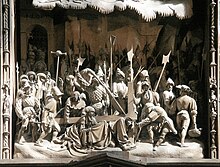Schleswig Cathedral

Schleswig Cathedral (
History
Predecessors
In 850 a missionary church was founded in Haithabu (
. After the foundation of the Schleswig diocese in 947, the first cathedral in Schleswig was built. Today, neither the size nor the location of this cathedral is known.Construction

In 1134, construction of a new romanesque basilica began. The work was only completed around 1200, because an additional nave was constructed that can still be seen today. Construction materials included granite, tuff from the Rhine, and brick.
In 1134, the Danish
After the collapse of two towers and some parts of the basilica in 1275, the High Gothic Hall Choir was constructed and completed around 1300.
The Late Gothic Hall Church was built from 1200 to 1408 and was finally completed in the 16th century. In 1894 that the cathedral got its final outward appearance. In 1879 Schleswig became the provincial capital in 1879, and in 1888 the construction of a
Beside the Gothic Altar of the
The cathedral in detail
The Petri Portal

Access to the cathedral is granted through the romanesque Petri Portal, dating back to 1180.
A variety of materials were used for the portal's construction: granite, red
.On the
Beside the portal, there is a weathered sculpture of a lion; another one can be found on the outer wall of the sacristy.
The sacristy
The
The High Choir
Bishop Berthold arranged for an expansion of the High Choir at the end of the 13th century. Also, frescos were added, depicting the
The Schwahl
The three-winged
The Brüggemann-Altar


The
Originally, the altar was manufactured for the Augustinian Chorherrenkirche (i.e. collegiate church) in Bordesholm. After the priory's dissolution, the Duke Christian Albrecht of Holstein-Gottorp arranged for the altar's transfer to Schleswig Cathedral in 1666. A young Emil Nolde helped with the altar's restoration in Flensburg at the end of the 19th century.
Cenotaph of Frederick I
In the northern choir nave, an elegant
stands only on six.The Blue Madonna
Jürgen Ovens (1623–1678) painted his Blue Madonna which was originally called Holy Family with Johannes, in 1669. It is situated on a pillar in the northern side nave. The influence of Anthony van Dyck is clearly visible on the baroque painting.
Jürgen Ovens, born 1623 in Tönning, was a pupil of
Central Tower
The central tower was constructed by
Burials
- Valdemar IV, Duke of Schleswig (?–1314)
- Eric II, Duke of Schleswig (1290–1325)
- Frederick I of Denmark
- Conrad von Reventlow
- Gustav Trolle
- Sophie of Pomerania
- Adolf, Duke of Holstein-Gottorp
- Christine of Hesse
- Frederick II, Duke of Holstein-Gottorp
- Philip, Duke of Holstein-Gottorp
- John Adolf, Duke of Holstein-Gottorp
- Augusta of Denmark
- Frederick III, Duke of Holstein-Gottorp
- Duchess Marie Elisabeth of Saxony
- Christian Albert, Duke of Holstein-Gottorp
- Princess Frederica Amalia of Denmark
- Frederick IV, Duke of Holstein-Gottorp
- Prince Charles of Hesse-Kassel
- Princess Louise of Denmark
- Prince Christian of Hesse
- Friedrich Wilhelm, Duke of Schleswig-Holstein-Sonderburg-Glücksburg
- Princess Louise Caroline of Hesse-Kassel
- Friedrich, Duke of Schleswig-Holstein-Sonderburg-Glücksburg
- Princess Adelheid of Schaumburg-Lippe
Further reading
The German Wikipedia has a large selection of books about the cathedral: Literature about Schleswig Cathedral (in German)
References
- ^ Huitfeldt, Arild. Danmarks Riges Krønike
External links
- Official Page of Schleswig Cathedral (in German)
